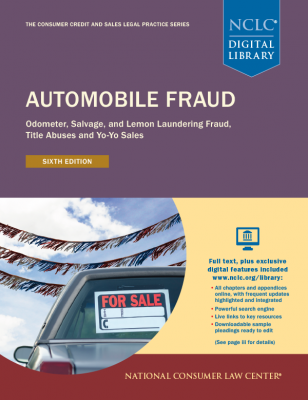Powerful Remedies
The Motor Vehicle Information and Cost Savings Act (sometimes known as the federal odometer act and described here as the “Act”), 49 U.S.C. § 32701, provides for $10,000 minimum damages, treble damages, and attorney fees for odometer tampering, mis-disclosure of information on vehicle title documents, certain oral misrepresentations, or for conspiracy involving Act violations. Significantly, certain car dealers display patterns of Act violations, leading to class actions with hundreds of class members, where statutory damages are in the millions of dollars. For more detail, see NCLC’s Automobile Fraud Chapter 6.
While intent is required for Act violations, there is a relaxed intent standard when a used car dealer engages in title disclosure or other Act violations. See NCLC’s Automobile Fraud § 5.8. The two-year limitations period does not begin to run until the consumer discovers or should have discovered the violation. NCLC’s Automobile Fraud § 6.4.1.
Act Provisions Now Apply to Older Vehicles
Currently, any vehicle over ten years old is exempted from the Act’s title disclosure requirements by the Act’s National Highway and Transportation Safety Administration (NHTSA) implementing regulations, even though there is evidence of more titling and odometer fraud involving these older vehicles than newer vehicles. The Act’s title disclosure requirements are central to fighting odometer rollbacks and other used car fraud, because they require a paper trail on the vehicle’s title showing the odometer mileage and other transfer information at every link in a vehicle’s title history.
While the ten-year exemption does not apply to violations based on the act of spinning an odometer, the older vehicle exemption for title disclosure requirements prevents the Act’s application to various types of used car titling fraud and makes it harder to prosecute odometer rollback cases. It is easier to show that a dealer falsely certified information on a title than it is to show that a particular dealer actually spun an odometer.
Effective January 1, 2020, the ten-year exemption is replaced with a twenty-year exemption. 2009 model year vehicles and older are grandfathered as exempt. Under the new regulation, vehicles with a 2010 model year or later are only exempt after 20 years. Thus 2010 model year cars will not be exempt from the title disclosure requirements until 2030. See 84 Fed. Reg. 52,664 (Oct. 2, 2019), amending 49 C.F.R. § 580.17(a).
As a practical matter, for transfers made in 2020, the rule’s impact is to extend Act coverage only to 2010 model year vehicles. But with each succeeding year more and more cars that would have formerly been exempted will now be covered.
The same NHTSA rulemaking also set out federal standards for electronic titling and electronic title disclosures. See 84 Fed. Reg. 52,664 (Oct. 2, 2019). The new standards will be significant only where a state decides to implement electronic titling. A number of states already have NHTSA authorization for electronic titling standards approved for that state. The new rule provides uniform standards nationwide. In the long run, the remaining states are likely to eventually switch to electronic titling. But such a major switch will take time in any given state.
Extensive Fraud Found in Vehicle Sales of Formerly Exempt Vehicles
Opening up the Act title disclosure requirements to older vehicles is significant because evidence points to extensive used car fraud among those older vehicles, providing new opportunities for used car litigation relying on the Act’s powerful remedies. For example, the National Odometer and Title Fraud Enforcement Association reports on a recent investigation that revealed a dealer rolled back odometers on 547 vehicles, of which, under the then existing law, 413 were exempt from the Act. See 84 Fed. Reg. at 52,683.
NHTSA estimates that more than 10 million vehicles with model years 11 to 20 years old are sold every year. See 84 Fed. Reg. at 52,695. NHTSA also relies on a Carfax study to estimate there are about 190,000 cases of odometer fraud a year, that each roll the odometer mileage back an average of 50,000 miles, with an average consumer injury of $4000. 84 Fed. Reg. at 52,695. Interestingly, this implies that for the average odometer case, treble damages will actually exceed the $10,000 statutory damages.
NHTSA also estimates that vehicles 11 to 20 years old account for 60% of vehicles that have had their odometers rolled back, meaning that every year approximately 114,000 of these older vehicles have their odometers spun—offering new opportunities for private litigation to obtain relief for victimized consumers. Of course, odometer fraud is just one type of used car fraud, and there is almost certainly far more fraud involving the sale of flood or salvage vehicles, lemon laundering, misrepresentation of prior use, and the like, which may all involve improper titling disclosures.
The clear implication of this data is that if a client purchased an older used car, particularly from a suspicious dealer, it is well worth the time to investigate possible used car fraud involving titling mis-disclosures or other Act violations. Not only will the client recover a minimum of $10,000, but there is every indication that a dealer engaging in one case of fraud may be involved in hundreds of similar cases, with a potential class recovery of millions of dollars. The new more limited exemption for older vehicles provides increased opportunities for consumer attorneys to use this a powerful tool to investigate and attack this fraud.
Ten Pointers on How to Uncover Odometer and Titling Fraud
- Obtain an inexpensive summary of the vehicle’s title history from the National Motor Vehicle Title Information System, Carfax, and/or AutoCheck, that may show odometer discrepancies. These title summaries do not always identify a vehicle’s problems, but this is a quick and inexpensive first step. See NCLC’s Automobile Fraud § 2.3.
- Look at the mileage indicated on repair or inspection stickers found on the driver’s door frame; the absence of such stickers where they should be found is suspicious.
- Papers in the glove compartment may include repair bills, service records, or other documents indicating prior vehicle mileage and other helpful information. A glove compartment devoid of paperwork is also suspicious.
- For vehicles with claimed low mileage (such as 25,000) look to the tire wear to see if the tires are too worn or not worn enough to match the vehicle’s mileage. The tire manufacture date should be close to the vehicle manufacture date—see NCLC’s Automobile Fraud § 2.2.3 to decipher the tire manufacture date from the code found on the tire’s sidewall.
- Manufacturers keep warranty repair information on a vehicle, including odometer information. A franchised dealer may be able to access this information for you. Taking the vehicle in for repair at a franchised dealer may also lead the dealer to inform the consumer of an odometer discrepancy. See NCLC’s Automobile Fraud § 2.2.7.
- A physical inspection of the vehicle can uncover an overall condition not matching the mileage on the odometer or indicating odometer tampering. The left-most digit may not line up with the others, the case may be scratched, white lines may appear between the odometer numbers, the odometer may record mileage inaccurately, or screws holding the dashboard may have been replaced. See NCLC’s Automobile Fraud § 2.2.5.
- An electronic odometer having strange read-outs is a good indicator of odometer tampering. See NCLC’s Automobile Fraud § 2.2.6.
- Depending on the manufacturer and model year, there may be a computer chip in the vehicle that measures mileage independently of the dashboard odometer so that a comparison can uncover an odometer rollback. See NCLC’s Automobile Fraud § 2.2.7.
- If anything looks suspicious, obtain a detailed title history from the state DMV. See NCLC’s Automobile Fraud § 2.4 for instructions and forms to accomplish this. A title history will also provide contact information for prior owners who can provide details about the vehicle history. It is also useful to compare the nature of a vehicle’s prior owners with the dealer’s representations as to their nature.
- The selling dealer is required by federal law to keep copies of title documents indicating both documents describing the dealer’s sale to the consumer and a prior sale to the dealer. See NCLC’s Automobile Fraud § 2.5.2.
How to Litigate Odometer and Titling Fraud Where a Vehicle Is Exempt from Act Disclosures
Disclosures on the title make investigating odometer and titling fraud much easier, and disclosure violations are easier to prove than actual odometer tampering. But the Act’s other provisions apply even to exempt vehicles, so that powerful Act remedies still apply to actual odometer tampering, failure to properly handle a repaired or replaced odometer, false statements made outside the disclosure form, and conspiracy. See NCLC’s Automobile Fraud Chapter 5.
In addition, if the odometer reading or other information on the title is not accurate, this is a breach of an express warranty, since the mileage on the odometer and the mileage and other information found on other documents in the sale are express warranties by the seller. Warranty claims can lead to actual damages and the consumer’s right to withhold car payments or revoke acceptance. Unlike the Act, for warranty claims there is no requirement to show intent. See NCLC’s Automobile Fraud § 9.2.3.2.1.
Odometer and titling misrepresentations are also violations of a state deceptive practices (UDAP) statute, which typically provides for attorney fees and often statutory or enhanced damages. Intent and knowledge may not be required for a UDAP recovery. See NCLC’s Automobile Fraud § 9.4.1.5.
A common law fraud claim may also be available, leading to punitive damages. See NCLC’s Automobile Fraud Chapter 8.


